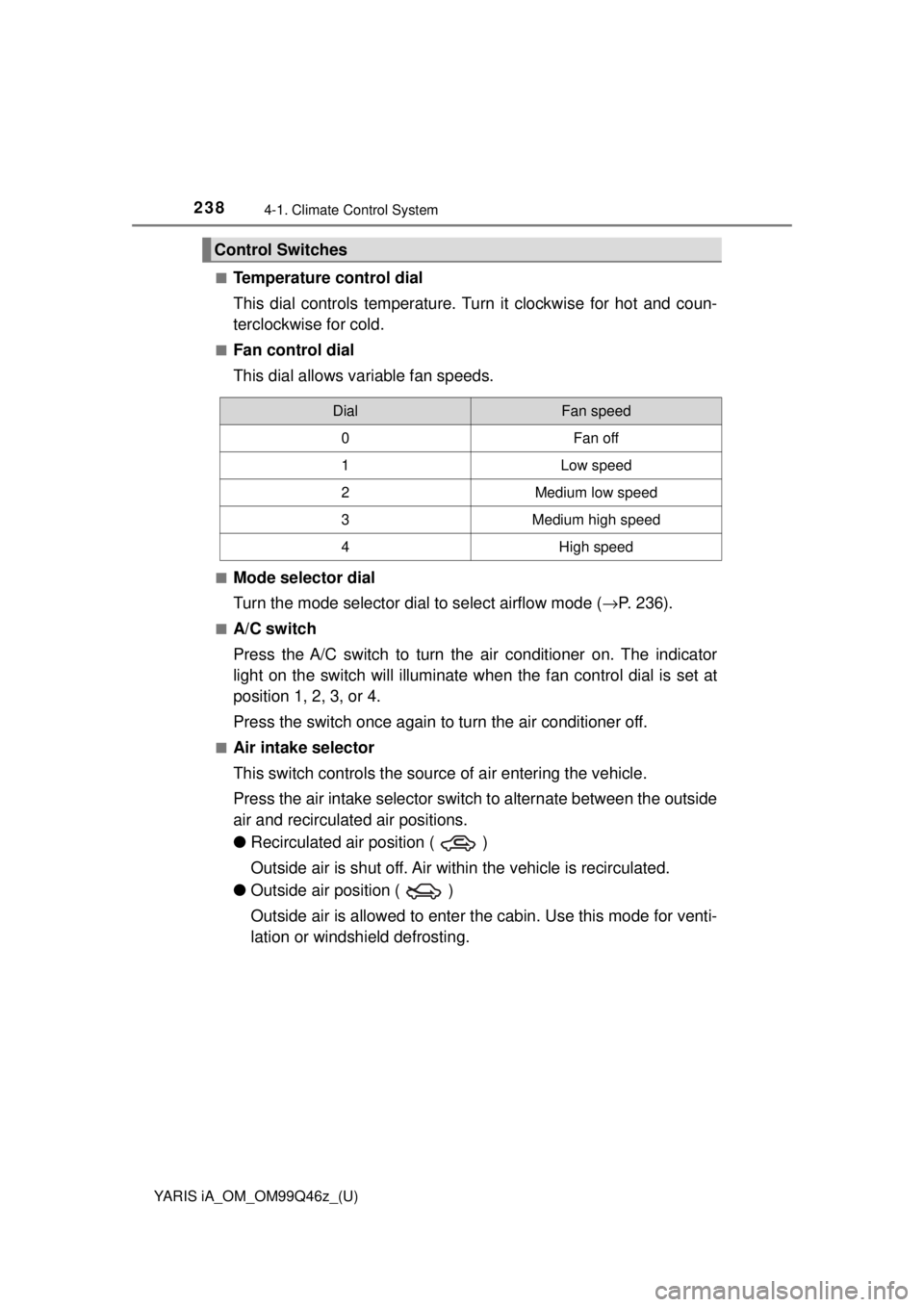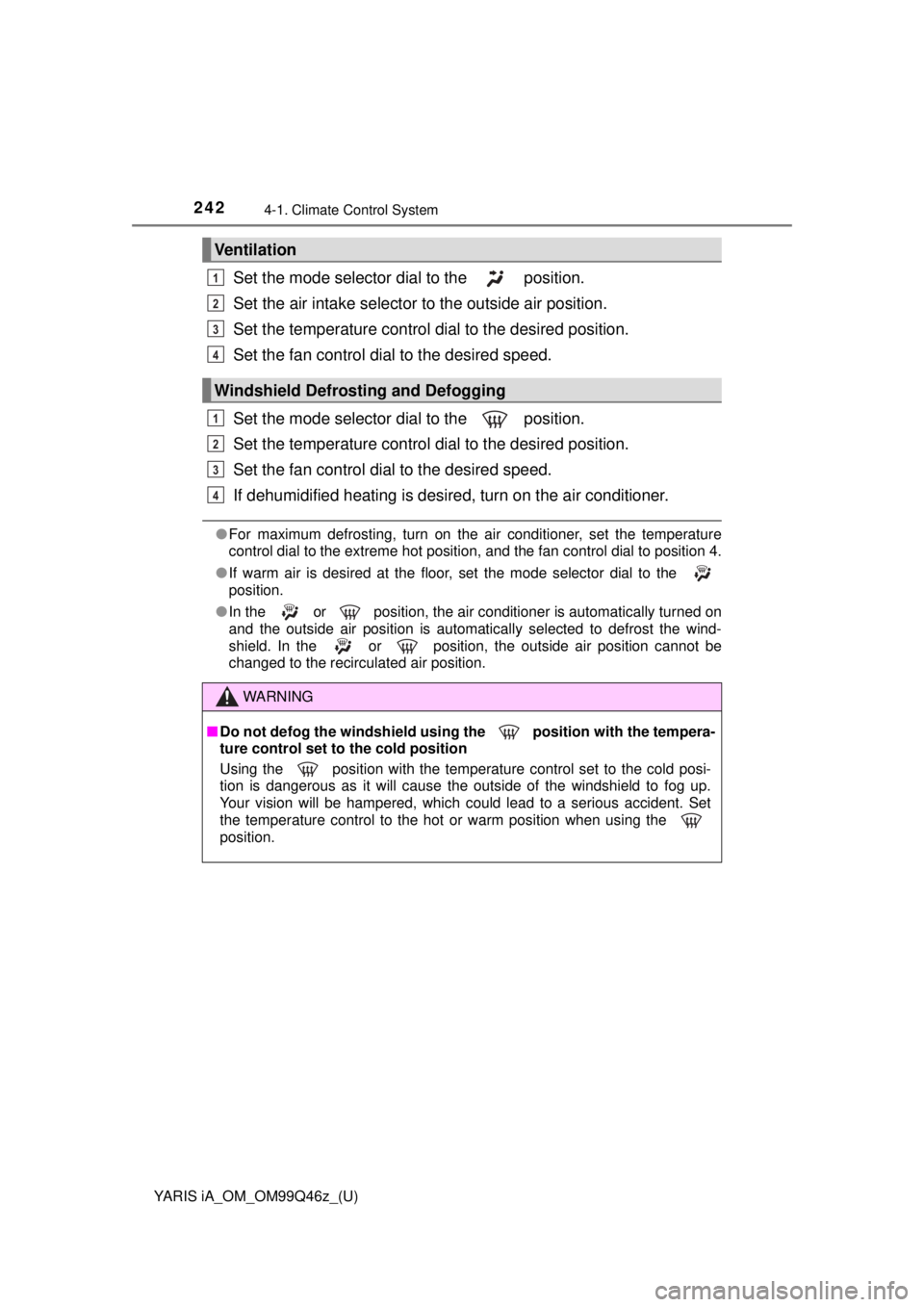2018 TOYOTA YARIS iA windshield
[x] Cancel search: windshieldPage 204 of 576

204
YARIS iA_OM_OM99Q46z_(U)
3-10. Active Safety System
Active Safety System∗
◆Pre-Crash Safety Technology
Pre-crash safety technology is designed to assist the driver in
averting collisions or re duce their severity in situations where they
cannot be avoided.
● Collision damage reduction in low vehicle speed range
Forward driving:
Smart City Brake Support (SCBS) ( →P. 205)
◆Sensor
● Laser sensor
The laser sensor emits a near-infrared laser beam and receives
the beam reflected off the reflec tive surface of a vehicle or
obstruction in front, and the detected beam is then used for mea-
surement. The laser sensor is used for the Smart City Brake
Support (SCBS) system.
The laser sensor is installed at the top of the windshield near the
rearview mirror.
Refer to Laser Sensor on P. 211.
∗: If equipped
Page 206 of 576

206
YARIS iA_OM_OM99Q46z_(U)
3-10. Active Safety System
●The Smart City Brake Support (SCBS) system will not operate if the driver is
deliberately performing driving operations (accelerator pedal and steering
wheel).
● The Smart City Brake Support (SCBS) system will operate under the follow-
ing conditions.
• The engine is running.
• The Smart City Brake Support (SCB S) warning light (amber) does not
illuminate.
• The vehicle speed is between about 2 to 18 mph (4 to 30 km/h).
• The Smart City Brake Support (SCBS) system is not turned off.
• The DSC is not malfunctioning.
● The Smart City Brake Support (SCBS) detects a vehicle ahead by emitting a
near-infrared laser beam and receiving the beam reflected off the reflector
of the vehicle ahead, and then using it for the measurement. Consequently,
the Smart City Brake Support (SCBS) may not operate under the following
conditions:
• Reflection of the laser is poor due to the shape of the vehicle ahead.
• The vehicle ahead is significantly dirty.
• Under bad weather condition, such as rain, fog and snow.
• The window washer is being used or the windshield wipers are not used
when it’s raining.
• The windshield is dirty.
• The steering wheel is turned completely left or right, or the vehicle is
accelerated rapidly and comes close to the vehicle ahead.
• Trucks with low loading platforms and vehicles with an extremely low or high profile.
• Vehicles with certain shapes such as a vehicle carrier.
● Under the following conditions, the Smart City Brake Support (SCBS) sys-
tem may not operate normally.
• Heavy luggage is loaded in the luggage compartment or on the rear seat.
• If there is the possibility of partial contact with a vehicle ahead.
• When driving on continuously curving roads, and entering and exiting
exits.
• Elongated luggage or cargo is loaded onto installed roof rails and covers the laser sensor.
• Exhaust gas from the vehicle in front, sand, snow, and water vapor rising
from manholes and grating, and water splashed into the air.
• When towing a malfunctioning vehicle.
• When driving with tires having significantly different wear.
Page 208 of 576

208
YARIS iA_OM_OM99Q46z_(U)
3-10. Active Safety System
WARNING
■Do not rely on the Smart City Br ake Support System (SCBS) as a sub-
stitute for safer driving
The Smart City Brake Support (SCB S) system cannot compensate for
unsafe and reckless driving, excessive speed, tailgating (following another
vehicle too closely), and driving on slippery roads such as wet, snowy, and
icy roads (reduced tire friction and road contact because of water on the
road surface). You can still have an accident.
■ Do not rely completely on the Sm art City Brake Support (SCBS) system
● The Smart City Brake Support (SCBS) system is only designed to reduce
damage in the event of a collision. Over reliance on the system leading to
the accelerator pedal or brake pedal being mistakenly operated could
result in an accident.
● The Smart City Brake Support (SCB S) is a system which operates in
response to a vehicle ahead. The system may not be able to detect or
react to two-wheeled vehicles or pedestrians.
● The laser sensor for the Smart City Brake Support (SCBS) system is
installed near the rearview mirror. To assure the correct operation of the
Smart City Brake Support (SCBS), heed the following cautions.
• Do not apply stickers to the surface of the windshield near the laser
sensor (including transparent stickers). Otherwise, the laser sensor
may not be able to detect vehicles ahead which could result in an acci-
dent.
• Do not apply coating agent to the windshield. Otherwise, the laser sen- sor may not be able to detect vehicles or obstructions in front which
could result in an accident.
• Do not disassemble the laser sensor.
• If cracks or damage caused by flying gravel or debris is visible near
the laser sensor, stop using the Smart City Brake Support (SCBS)
system immediately and have your vehicle inspected by your Toyota
dealer. If the vehicle continues to be driven with cracks or scratch
marks left on the windshield near the laser sensor, the system may
operate unnecessarily and cause an unexpected accident.
Refer to Stopping The Smart City Brake Support (SCBS) System
Operation on P. 210.
• When replacing the windshield wipers or windshield, consult your Toyota dealer.
● The laser sensor includes a function for detecting a soiled windshield and
informing the driver, however, depending on the conditions, it may not
detect plastic shopping bags, ice or snow on the windshield. In such
cases, the system cannot accurately determine a vehicle ahead and may
not be able to operate normally. Always drive carefully and pay attention to
the road ahead.
Page 211 of 576

211
YARIS iA_OM_OM99Q46z_(U)
3-10. Active Safety System
3
When Driving
Laser Sensor∗
Always keep the surface of the
windshield around the laser sen-
sor clean to assure proper opera-
tion of the Smart City Brake
Support (SCBS) system.
∗: If equipped
The Smart City Brake Support (SCBS) laser sensor is installed at
the top of the windshield near the rearview mirror.
WARNING
■ As there is the possibility of eye damage occurring from the laser,
always heed the following precautions
● Never remove the sensor.
● A removed sensor will not meet the conditions for a class 1M laser under
the IEC 60825-1 specification and therefore eye safety cannot be assured.
● Do not peer into the sensor using optical instruments with a magnification
function such as magnifying glasses, and microscopic and objective
lenses within a distance of 3.94 in. (100 mm) from the sensor.
Page 234 of 576

234
YARIS iA_OM_OM99Q46z_(U)
4-1. Climate Control System
Operating Tips
• Operate the climate control system with the engine running.
• To prevent the battery from being discharged, do not leave the fan
control dial on for a long period of time with the ignition switched
ON when the engine is not running.
• Clear all obstructions such as leaves, snow and ice from the hood and the air inlet in the cowl grille to improve the system efficiency.
• Use the climate control system to defog the windows and dehumid- ify the air.
• The recirculate mode should be used when driving through tunnels or while in a traffic jam, or when you would like to shut off outside
air for quick cooling of the interior.
• Use the outside air position for v entilation or windshield defrosting.
• If the vehicle has been parked in di rect sunlight during hot weather,
open the windows to let warm air escape, then run the climate con-
trol system.
• Run the air conditioner about 10 mi nutes at least once a month to
keep internal parts lubricated.
• Have the air conditioner checked before the weather gets hot. Lack of refrigerant may make the air conditioner less efficient.
The refrigerant specifications
are indicated on a label
attached to the inside of the
engine compartment. Check
the label before refilling the
refrigerant. If the wrong type of
refrigerant is used, it could
result in a serious malfunction
of the air conditioner.
For details, consult your Toyota
dealer.
Label
Page 238 of 576

238
YARIS iA_OM_OM99Q46z_(U)
4-1. Climate Control System
■Temperature control dial
This dial controls temperature. Turn it clockwise for hot and coun-
terclockwise for cold.
■Fan control dial
This dial allows variable fan speeds.
■Mode selector dial
Turn the mode selector dial to select airflow mode ( →P. 236).
■A/C switch
Press the A/C switch to turn the air conditioner on. The indicator
light on the switch will illuminate when the fan control dial is set at
position 1, 2, 3, or 4.
Press the switch once again to turn the air conditioner off.
■Air intake selector
This switch controls the source of air entering the vehicle.
Press the air intake selector switch to alternate between the outside
air and recirculated air positions.
● Recirculated air position ( )
Outside air is shut off. Air with in the vehicle is recirculated.
● Outside air position ( )
Outside air is allowed to enter th e cabin. Use this mode for venti-
lation or windshield defrosting.
Control Switches
DialFan speed
0Fan off
1Low speed
2Medium low speed
3Medium high speed
4High speed
Page 240 of 576

240
YARIS iA_OM_OM99Q46z_(U)
4-1. Climate Control System
Set the mode selector dial to the position.
Set the air intake selector to the outside air position.
Set the temperature control dial to the hot position.
Set the fan control dial to the desired speed.
If dehumidified heating is desired, turn on the air conditioner.
● If the windshield fogs up easily, set the mode selector dial to the posi-
tion.
● If cooler air is desired at face level, set the mode selector dial to the
position and adjust the temperature control dial to maintain maximum com-
fort.
● The air to the floor is warmer than air to the face (except when the tempera-
ture control dial is set at the extreme hot or cold position).
Heating
1
2
3
4
5
Page 242 of 576

242
YARIS iA_OM_OM99Q46z_(U)
4-1. Climate Control System
Set the mode selector dial to the position.
Set the air intake selector to the outside air position.
Set the temperature control dial to the desired position.
Set the fan control dial to the desired speed.
Set the mode selector dial to the position.
Set the temperature control dial to the desired position.
Set the fan control dial to the desired speed.
If dehumidified heating is desired, turn on the air conditioner.
● For maximum defrosting, turn on the air conditioner, set the temperature
control dial to the extreme hot position, and the fan control dial to position 4.
● If warm air is desired at the floor, set the mode selector dial to the
position.
● In the or position, the air conditioner is automatically turned on
and the outside air position is automatically selected to defrost the wind-
shield. In the or position, the outside air position cannot be
changed to the recirculated air position.
Ventilation
Windshield Defrosting and Defogging
WARNING
■Do not defog the windshield using the position with the tempera-
ture control set to the cold position
Using the position with the temperature control set to the cold posi-
tion is dangerous as it will cause the outside of the windshield to fog up.
Your vision will be hampered, which could lead to a serious accident. Set
the temperature control to the hot or warm position when using the
position.
1
2
3
4
1
2
3
4